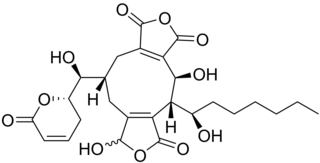A mycotoxin is a toxic secondary metabolite produced by organisms of kingdom Fungi and is capable of causing disease and death in both humans and other animals. The term 'mycotoxin' is usually reserved for the toxic chemical products produced by fungi that readily colonize crops.

Citrinin is a mycotoxin which is often found in food. It is a secondary metabolite produced by fungi that contaminates long-stored food and it causes different toxic effects, like nephrotoxic, hepatotoxic and cytotoxic effects. Citrinin is mainly found in stored grains, but sometimes also in fruits and other plant products.
Mycotoxicology is the branch of mycology that focuses on analyzing and studying the toxins produced by fungi, known as mycotoxins. In the food industry it is important to adopt measures that keep mycotoxin levels as low as practicable, especially those that are heat-stable. These chemical compounds are the result of secondary metabolism initiated in response to specific developmental or environmental signals. This includes biological stress from the environment, such as lower nutrients or competition for those available. Under this secondary path the fungus produces a wide array of compounds in order to gain some level of advantage, such as incrementing the efficiency of metabolic processes to gain more energy from less food, or attacking other microorganisms and being able to use their remains as a food source.

Penicillium purpurogenum is a plant pathogen infecting strawberries. It produces rubratoxin B, a mycotoxin with anticarcinogenic properties, as well as monascus pigments.

Roquefortine C is a mycotoxin that belongs to a class of naturally occurring 2,5-diketopiperazines produced by various fungi, particularly species from the genus Penicillium. It was first isolated from a strain of Penicillium roqueforti, a species commercially used as a source of proteolytic and lipolytic enzymes during maturation of the blue-veined cheeses, Roquefort, Danish Blue, Stilton and Gorgonzola.

Cyclochlorotine (CC), also known as islanditoxin is a mycotoxin produced by the fungus Penicillium islandicum that causes liver damage and has carcinogenic properties. Japanese researchers confirmed that it was one of three strains of Penicillin fungi responsible for yellowed rice. It is listed as an IARC Group 3 carcinogen.

Rubratoxins are hepatotoxic mycotoxin produced by Penicillium rubrum and Penicillium purpurogenum. Rubratoxin A and rubratoxin B have been known since 1950s, while rubratoxin C was recently reported. Rubratoxins are also known as protein phosphatase 2A (PP2A) specific inhibitor. The PP2A inhibitory activity of rubratoxin A is about 100-fold higher than rubratoxin B and rubratoxin A is now used as a chemical probe for PP2A research.
Penicillium islandicum is an anamorph species of the genus of Penicillium which produces luteoskyrin, simatoxin, cyclochlorotine, rugulosin, islanditoxin and chitosanase.
Penicillium jensenii is an anamorph species of the genus of Penicillium which produces citrinin, griseofulvin and fumagillin.
Yellowed rice refers to three kinds of rice grains contaminated with different strains of Penicillium fungi—Yellow rice, Citrinum yellow rice, and Islandia yellow rice. These rice grains were first identified in Japan in 1964, after the research was interrupted by World War II. The first of the yellowed rice strains has been linked to shoshin-kakke. Citrinum yellow rice and Islandia yellow rice are not known to have caused any adverse effects in human populations.
Penicillium melinii is an anamorph species of the genus Penicillium which produces griseofulvin and beta-Nitropropionic acid.
Penicillium ochrosalmoneum is an anamorph, ascosporic species in the genus Penicillium which produces citreoviridin.
Penicillium polonicum is a species of fungus in the genus Penicillium which produces penicillic acid, verucosidin, patulin, anacine, 3-methoxyviridicatin and glycopeptides. Penicillium polonicum can spoil cereals, peanuts, onions, dried meats, citrus fruits
Penicillium raistrickii is an anamorph species of fungus in the genus Penicillium which produces griseofulvin, patulin and verruculogen.
Penicillium rubrum is a species of fungus in the genus Penicillium which produces kojic acid, mitorubrin, mitorubrinol, rubratoxin A, rubratoxin B rubralactone, rubramin and occurs in grain corn and soybeans. Penicillium rubrum is similar to the species Penicillium chrysogenum.
Penicillium rugulosum is an anamorph species of fungus in the genus Penicillium which produces inulinase, luteoskyrin and (+) rugulosin.
Penicillium tardum is an anamorph species of fungus in the genus Penicillium which produces rugulosin.
Penicillium velutinum is an anamorph species of fungus in the genus Penicillium which was isolated from soil in the United States. It produces verruculogen, verrucosidin, verruculotoxin, decalpenic acid, dehydroaltenusin, cyciooctasulfur, atrovenetinone, altenusin and penitrem A
Penicillium viridicatum is a psychrophilic species of fungus in the genus, penicillic acid and citrinin. Penicillium viridicatum can spoil grapes and melons.

Rugulosin is an anthraquinoid mycotoxin with the molecular formula C30H22O10 which is produced by Penicillium species. Rugulosin is hepatotoxic and is cancerogenic.






